The iPhone 4 Redux: Analyzing Apple's iOS 4.0.1 Signal Fix & Antenna Issue
by Brian Klug & Anand Lal Shimpi on July 15, 2010 12:28 PM EST- Posted in
- Smartphones
- Apple
- iOS 4
- iPhone 4
- Mobile
Better at the Low End, Mixed Feelings Everywhere Else
Brian came up with the plan to enable the numerical signal strength visualization and executed on it very well in our original iPhone 4 review. Since then there’s been a disturbing amount of debate as to whether or not this actually amounts to a problem with the phone.
Part of the confusion stems from the fact that doing this sort of antenna testing in a real world scenario is time intensive. As Brian mentioned on the previous page, for today’s article both of us were driving around our respective cities, stopping at various locations, measuring signal strength and comparing it to bar mappings in order to produce the charts you saw on the other page.
There’s no denying that Apple has played a significant role in why there continues to be debate about the iPhone 4 antenna. By simply addressing the pre-4.0.1 bars not being a good representation of signal strength and ignoring the fact that the iPhone 4 does lose more signal strength than competing phones depending on how you hold it, Apple manages to convince its faithful that there’s nothing wrong while driving its critics to demand a recall.
My mother always taught me that honesty is the best policy and presumably I’m not the only one in the world who was privy to this information. Had Apple come clean with both of these facts (the bar mapping and the signal attenuation issue) early on we’d be in a far more clear cut world today.
We have consistently argued that the 4’s antenna is a design choice by Apple. As we’ve seen in our testing there are situations where the iPhone 4’s antenna makes things better (e.g. holding onto calls with very low signal strength) and other situations where the design makes them worse (e.g. holding it wrong in situations with low signal strength). I wanted to describe the inconsistency in greater detail so I went out with an iPhone 3GS and 4 and documented my experiences.
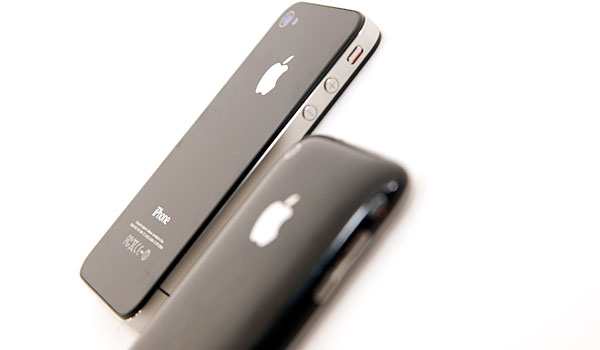
In practice I found three things that were true about the iPhone 4’s antenna behavior compared to the 3GS.
Reception in average conditions is sometimes significantly better on the iPhone 4 than on the 3GS. Take a look at the image capture below. In the same exact location we have better reception on the 4 than the 3GS. Granted this could be due to a number of variables outside of the phone’s antenna itself, but it happened enough times that it’s worth reporting. This is the positive to Apple’s external antenna design - you can and do get better reception. Unfortunately the tradeoff is the scenario I just described before this.
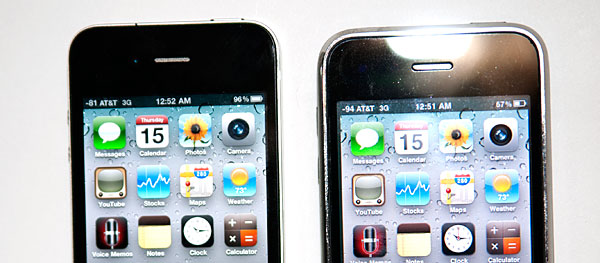
iPhone 4 (left) at -81 dBm vs. iPhone 3GS (right) at -94 dBm
Signal strength is sometimes the same as or worse than the iPhone 3GS. This is really where the problem comes into play. In the shot below I have the 4 and 3GS sitting next to one another and they are displaying roughly the same signal strength. We’ve already proven that holding the iPhone 4 attenuates its signal more than the 3GS, which results in the frustration we’ve seen expressed by many at this point. In situations where the 4 has the same signal as the 3GS, holding the phone is going to drop it to levels significantly worse than the 3GS. If you’re in an area with low signal strength to begin with, holding the phone is going to bring you down to dangerously low levels.
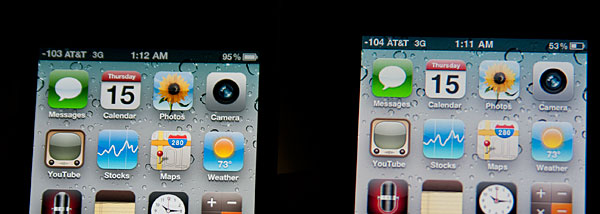
iPhone 4 (left) at -103 dBm vs. iPhone 3GS (right) at -104 dBm
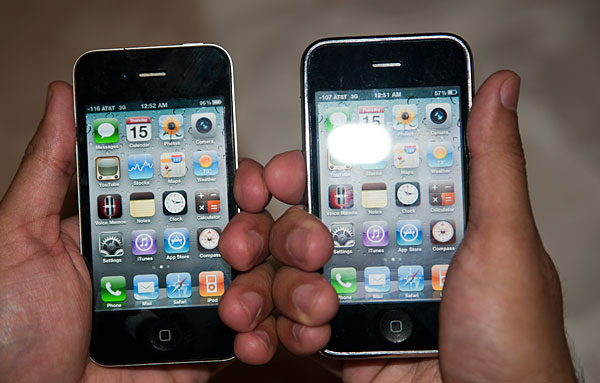
iPhone 4 being held tightly (left) at -115 dBm vs. iPhone 3GS being held tightly (right) at -107 dBm
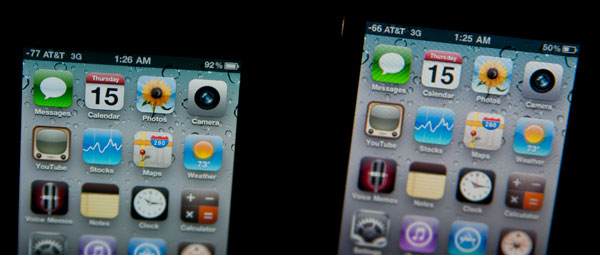
iPhone 4 (left) at -77 dBm vs. iPhone 3GS (right) at -66 dBm
The iPhone 4 is better at holding onto calls and data at very low signal levels. We’ve mentioned this one before but it’s worth reiterating. The new antenna does let me make calls and transmit data at very low signal strength. With the iOS 4.0.1 update I was able to make a call at -115dB on the 3GS, however the call did drop within a minute of starting it. By comparison I was able to have a much longer conversation without dropping the call at -120dB on the 4. By no means is this a scientific comparison, but anecdotally both Brian and I feel that the low signal strength performance of the iPhone 4 is better than the 3GS.

A call at -120 dBm on the iPhone 4
If you’re keeping tabs you’ll note that this is what is traditionally referred to as a trade off. Apple opted for good performance in low signal situations (and style of course) over maintaining consistently better or unchanged radio performance compared to the 3GS. I would personally consider this to be an unnecessarily risky design choice, particularly for a smartphone vendor. Note that it's nearly impossible to separate out the antenna from the rest of the iPhone 4 platform to determine exactly what is responsible for the phone's signal sensitivity in various situations. All we ultimately know is how physically interacting with the antenna impacts reported signal strength.
I can’t stress enough that this issue impacts all users. The variability is in how strong of a signal you have to begin with. That’s the absolute only reason there’s debate in these discussions from phone to phone. At my desk I don’t get great reception on AT&T. With the iPhone 4 I’m usually at -96dBm. If I keep a tight grip on the phone or if I’m holding it to send text messages I can sometimes lose all signal entirely. This is a combination of poor reception at my house and the fact that the 4 loses more of its signal than other phones when held certain ways.
Brian on the other hand has much better reception at his home. To him, the signal strength drops but it does not drop enough for this to be a problem. I consider myself to be on the border. If I’m mindful of how I’m holding the phone it’s not an issue, and even most of the time if I’m not paying attention to it it’s not an issue. However there are definitely times when it does become a problem. I wouldn’t consider it to be the majority of the time or even more than 10% of the time, but it happens enough for me to have to think about it. Ultimately this is why I consider Apple’s design here to be unnecessarily risky. Introducing a change with stylistic and technical benefits where the downside is limited but potentially very noticeable is just ballsy.
Luckily for Apple, there are things that can be done about it.










146 Comments
View All Comments
SunSamurai - Thursday, July 15, 2010 - link
People like you are not missed. All you are is an apple basher. The phone has bugs that need to be worked out, calling broken is foolish and only shows your maturity and bias.trochevs - Thursday, July 15, 2010 - link
Mr. Anand Lal Shimpi,I love your articles, because they are very accurate, fact based, and clearly separate fact from personal options. But I feel in this particular case you are letting your personal love for Apple to ignore the facts a bit here. I have big problem with following two sections:
"We have consistently argued that the 4’s antenna is a design choice by Apple. As we’ve seen in our testing there are situations where the iPhone 4’s antenna makes things better (e.g. holding onto calls with very low signal strength) and other situations where the design makes them worse (e.g. holding it wrong in situations with low signal strength)."
"The iPhone 4 is better at holding onto calls and data at very low signal levels. We’ve mentioned this one before but it’s worth reiterating. The new antenna does let me make calls and transmit data at very low signal strength. With the iOS 4.1 update I was able to make a call at -115dB on the 3GS, however the call did drop within a minute of starting it. By comparison I was able to have a much longer conversation without dropping the call at -120dB on the 4. By no means is this a scientific comparison, but anecdotally both Brian and I feel that the low signal strength performance of the iPhone 4 is better than the 3GS."
First some facts that I have picked up while I study RF tech in order to get my M.S. in EE:
1.The signal level is measured by the receiver circuits. Usually it is the voltage that regulate the Automatic Gain Loop that is used to maintain constant signal level at the input of detector circuit.
As result any antenna gains would be clearly visible as improve signal level at all time.
2.The antenna is passive device as result it have static efficiency and antenna gain does not depends on signal strength.
I would like to point out to you inconsistency in your analysis:
1. If you can maintain better call at -120dB with iPhone4, but you can't do the same with iPhone 3Gs proves that iPhone4 have better receiver/decoder circuit then iPhone 3Gs only.
2.If the iPhone 4 antenna is better then 3Gs you are going to see better signal level on iPhone 4 in anywhere like places where the signal is strong and especially where the signal is weak. But all your test clearly shows that receiver in iPhone 4 has to work harder in order to compensate for bad antenna.
To remind you: “My mother always taught me that honesty is the best policy ...
”
So please be truthful to this statement and stop with the apologies on Apple's behalf. The only apology we need is one coming from Apple and it should be very short: “We made a mistake and we are going to fix it” that's it. Stop saying that iPhone 4's antenna is some kind of engineering compromise, because it is not. The antenna design is crap. Credits for the better operation of iPhone 4 in low signal are due to the base-band chip designer/manufacture. Please acknowledge that, they really deserve it, no Apple.
SunSamurai - Friday, July 16, 2010 - link
The ntenna design is not crap. It simply need a revision to fullfill what it was aiming for. If it were crap then they would need to fully redesign it. They do not.leexgx - Friday, July 16, 2010 - link
fast fix is just give out the bumper case and have it come with every iphoneif i was going to get an iphone (and i am not) the first thing i would buy is the case or full case(protect the back and front) as it not that hard to shatter the screen or the back now
most of my house all runs on Android based phones here from when posting(apart form my main phone thats HTC HD1 WIN 6.1 for business use but i am considering going all Android as text input is faster under my desire phone)
T-mobile G1 thats been passed down (main issue bat is crap had to fit an 2000mha bat to make the phone usefull) ,
upgrade to T-mobile HTC desire as my second phone HD1 main (bigger bat as default seems to last day and an half now),
Orange - Sony X10 {big one} works well big screen and big cam on it (only bad thing is seems to be an finger smugs magnet on the screen)
Orange Samsung Galaxy S (that looks more like an iphone with the middle button)
iwod - Thursday, July 15, 2010 - link
I dont think anand is Pro Apple, it sounds more like you are Anti Apple.The Antenna is not broken. It may have faults and its problem. But it still does calls and data in most if not all situation. Well thanks to US which has poor coverage and signal from AT&T. You will be worse then others around the world.
If i put how Motorola's design and tune their Antenna as Standard. Then pretty much 95% of all phone sold by Non Motos have problems. Or according to your wording, Broken.
It doesn't come with a broken USB Port.
Bluetooth is an Software problem.
If you can not stand software problems, then dont even go on to internet. Because every single devices on earth have it. And you should complain about Windows Mobile first.
slickr - Friday, July 16, 2010 - link
O please spare me the lecture.I have not expressed in any way that I'm anti Apple now have I, but when I see a bad device and Anandtech staff trying to defend Apple and say that users are wrong for "holding it wrong", its just the bars and not the antenna that is wrong, makes me sick.
I have huge respect for this website, but right now some of that respect is shattered.
You sir, can not comprehend the facts! If the antenna can't catch signal if you are holding it in a particular way that is considered broken. That's like Razor mouse not registering movements if you put your hand on it in a particular way. Yes it may work 80% of the time, but that does not change the fact it wont work 20% of the time.
There are several reports of broken or in other words faulty USB port. In some instances on some iPhone 4 the USB makes an electrical surge when connected with a USB cable and it gets destroyed. This is firstly not safe for the health of the users and screws your iPhone 4, so you need to get it to service to repair the broken USB port.
How do you know bluetooth problems are software? This is the Apple favoritism. It may or may not be software problem, but the fact is there is a problem with it.
If you go buy Apple I don't care, its your personal opinion, but having a huge and well known website advertise Apple in these articles if beyond all credibility !!!
SunSamurai - Friday, July 16, 2010 - link
Its not considered broken, because it still works. Try the dictionary before telling people to comprehend words ;)slickr - Saturday, July 17, 2010 - link
It only works part time, so its broken.Take this for example: Your brand new $500 dollars TV all of a sudden stops working, than after placing it in a different position starts working again, than the problem occurs again and you move it again. No matter what you do it still keeps reoccurring and the only way to fix it is by buying additional stuff for it.
I consider that broken and would never want to buy a TV from that manufacturer again, but it the case of Apple's iPhone 4 its being defended and promoted as user problem for "holding it wrong" Come on.
And that is only one of the multiple problems Apple has with the iPhone!
anandreader - Sunday, July 18, 2010 - link
It's broken for some people, not for others. I don't experience the problem because I avoid touching the antenna at the gap. I'm also right handed so that's easy for me. For a left-handed person, yeah it's going to be broken if they can't hold it the way they'd like to hold it.For me, the phone is better than any other cell phone I've had. When I'm in a strong signal area, the phone sounds like a landline phone - the voice on the other end is crisp and static free.
Bottom line - the antenna is only an issue for some, not all, people. Your statement that the antenna is broken is overly broad.
slickr - Tuesday, July 20, 2010 - link
You just proved my point, even if only 10 out of 10 million people are affected its broken. And it could also happen to you and any other in any case, just touch is in the spot and the antenna loose connection and whoala a problem.Plus iPhone 4 is crap in other areas too, I'd gladly take the Samsung or Nokia N900 any day over the iPhone!